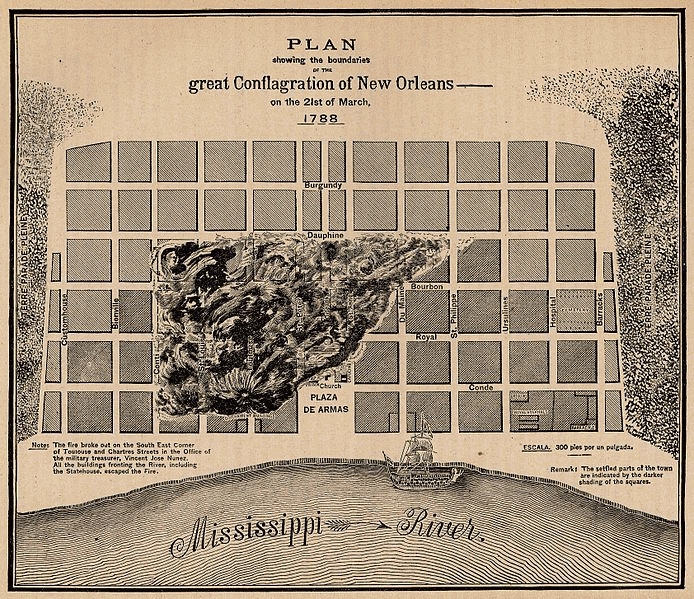|
Today in New Orleans History |
|
|
March 21


 The Good
Friday fire started about 1:30 p.m. at the home of Army Treasurer Don Vincente Jose Nunez, 619 Chartres Street at Toulouse
Street, less than a block from Jackson Square (Plaza de Armas). Because the fire was on Good Friday, priests refused to allow
church bells to be rung as a fire alarm. Within five hours it had consumed almost the entire city as it was fed by a strong
wind from the southeast. The fire destroyed the original Cabildo and virtually all major buildings in the French Quarter,
including the city's main church, the municipal building, the army barracks, armory, and jail. Only two fire engines were
operational, and they were destroyed by the fire. Louisiana Governor Esteban Rodríguez Miró set up tents for
the homeless. The fire area stretched between Dauphine Street and the Mississippi River and between
Conti Street in the south and St. Philip Street in the north. It spared the river-front buildings including the Customs House,
the tobacco warehouses, the Governor's Building, the Royal Hospital and the Ursulines Convent. The
Spanish were to replace the wooden buildings with structures with courtyards, thick brick walls, arcades, and wrought iron
balconies. Among the new buildings were the signature New Orleans buildings of St. Louis Cathedral, The Cabildo and the Presbytere. Governor Miro's report summarized the suffering: If the imagination
could describe what our senses enable us to feel from sight and touch, reason itself would recoil in horror, and it is no
easy matter to say whether the sight of an entire city in flames was more horrible to behold than the suffering and pitiable
condition in which everyone was involved. Mothers, in search of a sanctuary or refuge for their little ones, and abandoning
- their earthly goods to the greed of the relentless enemy, would retire to out-of-the-way places rather than be witnesses
of their utter ruin. Fathers and husbands were busy in saving whatever objects the rapidly spreading flames would permit
them to bear off, while the general bewilderment was such as to prevent them from finding even for these a place of security.
The obscurity of the night coming on threw its mantle for a while over the saddening spectacle; but more horrible still
was the sight, when day began to dawn, of entire families pouring forth into the public highways, yielding to their lamentations
and despair, who, but a few hours before, had been basking in the enjoyment of more than the ordinary comforts of life.
The tears, the heartbreaking sobs and the pallid faces of the wretched people mirrored the dire fatality that had overcome
a city, now in ruins, transformed within the space of five hours into an arid and fearful, desert. Such was the sad ending
of a work of death, the result of seventy years of industry.  

To receive an update for each day in New Orleans
history, join our facebook page
- Today in New Orleans History
On March 21, 2012, the NFL issued sanctions to Saints coaches and front-office personnel
for their roles in an alleged bounty scandal. Williams was suspended indefinitely, and was banned from applying for reinstatement
until the end of the 2012 season at the earliest. Payton was suspended for the entire 2012 season, effective April 1. He
is the first head coach in modern NFL history to be suspended for any reason. Loomis was suspended for the first eight
games of the 2012 season. Vitt, who had been tabbed as a possible candidate to serve as interim coach in Payton's absence,
was suspended for the first six games of the 2012 season (This did not automatically disqualify Vitt from serving as interim
head coach per se, as his suspension was not effective until the regular season; the suspension terms allowed him to coach
the team through training camp and the preseason, then return during Week 7. The Saints announced they would implement this
scenario for 2012.) The Saints were also fined $500,000—the maximum fine permitted under the league constitution.
Goodell also stripped the Saints of their second-round draft picks in 2012 and 2013. Photo of Arthur J. Heyd, Superintendent of the New Orleans Fire Department, Captain Victor Mahne, Planning Officer for the NOFD, and Assistant Superintendent Louis J. San Salvador, March 21, 1968 displaying a plan for a new fire station.
|
|
|

To receive an update for each day in New Orleans history,
join our facebook page - Today in New
Orleans History.
Analytics |
 The Great New Orleans Fire (1788) was a fire that destroyed 856 of the 1,100 structures in New Orleans, Louisiana on March
21, 1788, spanning the south central French Quarter from Burgundy to Chartres Street, almost to the riverfront buildings.
An additional 212 buildings were destroyed in a later city-wide fire, on December 8, 1794.
The Great New Orleans Fire (1788) was a fire that destroyed 856 of the 1,100 structures in New Orleans, Louisiana on March
21, 1788, spanning the south central French Quarter from Burgundy to Chartres Street, almost to the riverfront buildings.
An additional 212 buildings were destroyed in a later city-wide fire, on December 8, 1794.
